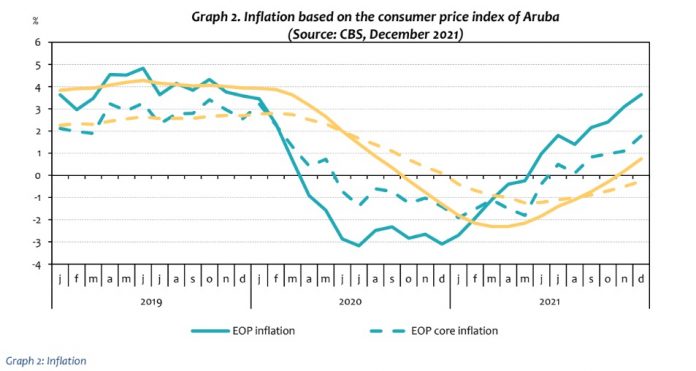During its meeting of February 10, 2022, and after reviewing the most recent economic and monetary data, the Monetary Policy Committee (MPC) of the Centrale Bank van Aruba (CBA) decided to raise the reserve requirement rate from 14.0 percent to 16.0 percent as of March 1st, 2022.
This decision was primarily based on the elevated level of excess liquidity at the commercial banks, and the modest effect of the previous increases in the reserve requirement rate on the level of excess liquidity at the commercial banks.
The following information and analysis were considered in reaching this decision:
International reserves
International reserves (including revaluation differences of gold and foreign exchange holdings), up to and including January 21, 2022, increased by Afl. 49.8 million compared to the end of December 2021. The growth in the international reserves was mainly driven by tourism services. Meanwhile, official reserves rose by Afl. 16.5 million. Consequently, the official and international reserves reached, respectively, Afl. 2,761.4 million and Afl. 3,179.4 million as of January 21, 2022 (Graph 1). Accordingly, the level of reserves remained adequate when benchmarked against the current account payments and the IMF ARA metric (Table 1).
Credit developments
In December 2021, total credit of the commercial banks contracted by Afl. 139.3 million or 3.5 percent to Afl. 3,824.8 million, when compared to the end of 2020. This decline was caused by the categories ‘other’ (-Afl. 90.0 million/ -17.7 percent), ‘loans to individuals’ (-Afl. 26.0 million/ -1.4 percent), and ‘business loans’ (-Afl. 22.4 million/ -1.5 percent). The fall in the category ‘other’ was primarily the result of a lower amount of government bonds held by the local commercial banks. The drop in the category ‘loans to individuals’ was due to a decrease in ‘consumer credit’, which was only partly mitigated by an increase in housing mortgages. The contraction in the category ‘business loans’, in turn, resulted from downturns in commercial mortgages, as well as current account and term loans.
Inflation
In December 2021, the Consumer Price Index (CPI) rose by 3.6 percent compared to the corresponding month a year earlier. The twelve-month average inflation rate amounted to 0.7 percent in December 2021, 0.5 percentage point higher than the previous month (Graph 2). The rise in the CPI compared to a year earlier was mainly caused by higher gasoline prices, which also affected the ‘transport’ component (1.9 percentage points contribution). This increase was amplified by higher prices for the components ‘household operation’ (0.6 percentage point contribution), ‘food’ (0.5 percentage point contribution), ‘recreation and culture’ (0.3 percentage point contribution), ‘miscellaneous goods and services’ (0.2 percentage point contribution), ‘housing’ (0.1 percentage point contribution), and ‘restaurants and hotels’ (0.1 percentage point contribution). These upturns were slightly offset by lower prices for the ‘health’ component (-0.1 percentage point contribution). All other components remained unchanged.
Commercial bank liquidity
The aggregate excess liquidity of commercial banks rose to Afl. 1,320.5 million in December 2021, compared to Afl. 1,107.4 million in December 2020 (Graph 3).
The monthly comparison showed an expansion in aggregated excess liquidity in December 2021, compared to November 2021, despite a one percentage point increase in the reserve requirement on the 1st of December 2021. The increase in the reserve requirement rate was counterbalanced by a rise in the total liquid funds held by the commercial banks. Consequently, the level of excess liquidity went up and remained significantly above pre-pandemic levels.
The elevated level of excess liquidity at the commercial banks is partly the result of the continued subdued credit demand. Furthermore, the wage subsidy and FASE programs of the GoA to cushion the economic effects of the COVID-19 crisis likely also contributed to the high level of excess liquidity.
Meanwhile, the prudential liquidity ratio of the commercial banks, which measures the percentage of their liquid assets to their total net assets, remained at a comfortable level of 38.0 percent in December 2021, far above the minimum required prudential liquidity ratio of 18.0 percent.

















